Burrowing owls’ habitat losses have wildlife experts working to relocate them
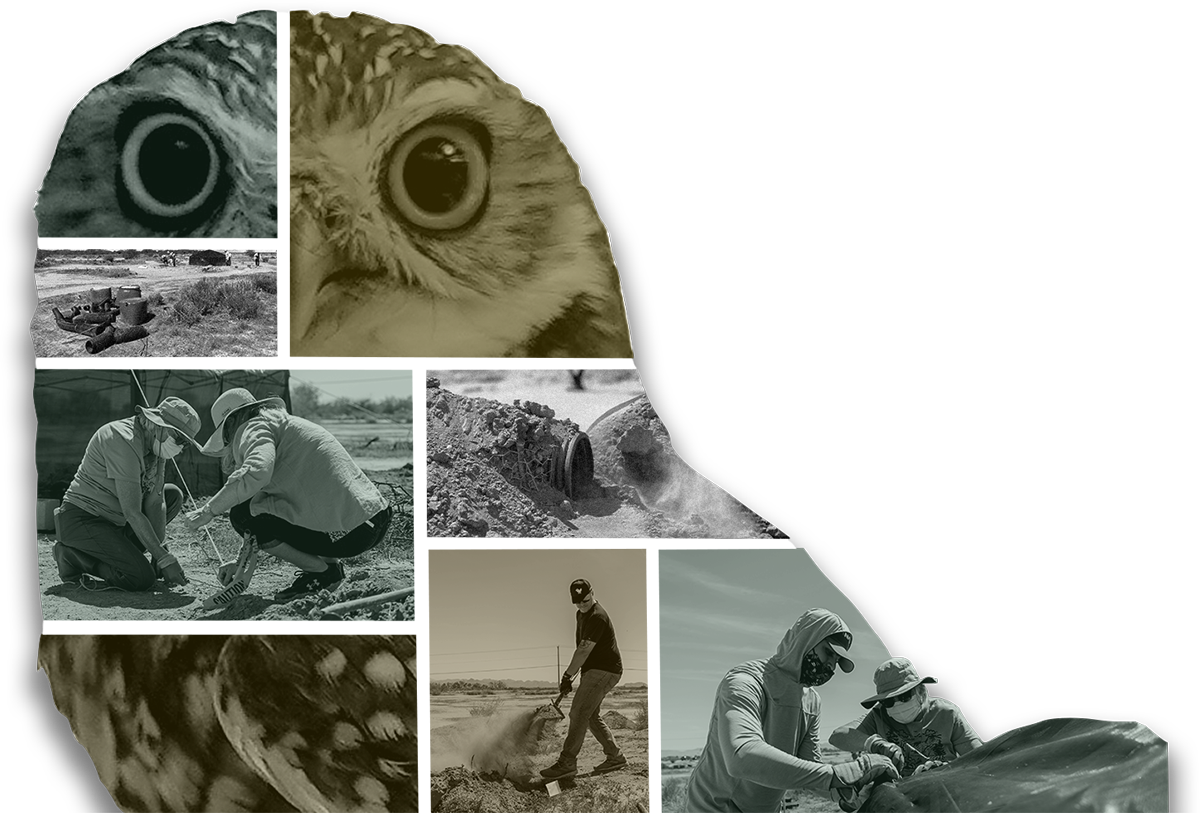

(Photo illustration by Samantha Chow/Cronkite News)
FLORENCE – Greg Clark gingerly handles a pair of cardboard carriers – each containing two small owls – as he joins a knot of sweating volunteers hammering stakes into the soil and shoveling dirt to seal the bottom of a big tent made of black netting.
Clark, the burrowing owl habitat coordinator for the raptor conservation group Wild at Heart, and the volunteers worked to assemble temporary housing for 20 burrowing owls that were being relocated from Buckeye and other sites in the West Valley. The owls, which are listed as a species of concern in Arizona, were driven from their habitat by development. Their new homes near Florence are in an empty lot beside a swath of farmland.
“Every day, there is some construction for new houses, a shopping center or a warehouse somewhere in Phoenix, Pinal County or greater Maricopa County,” Clark said.
As more open desert and farmland is developed, burrowing owls are being relocated to new sites through the collaboration of Wild at Heart, environmental organizations and volunteers.
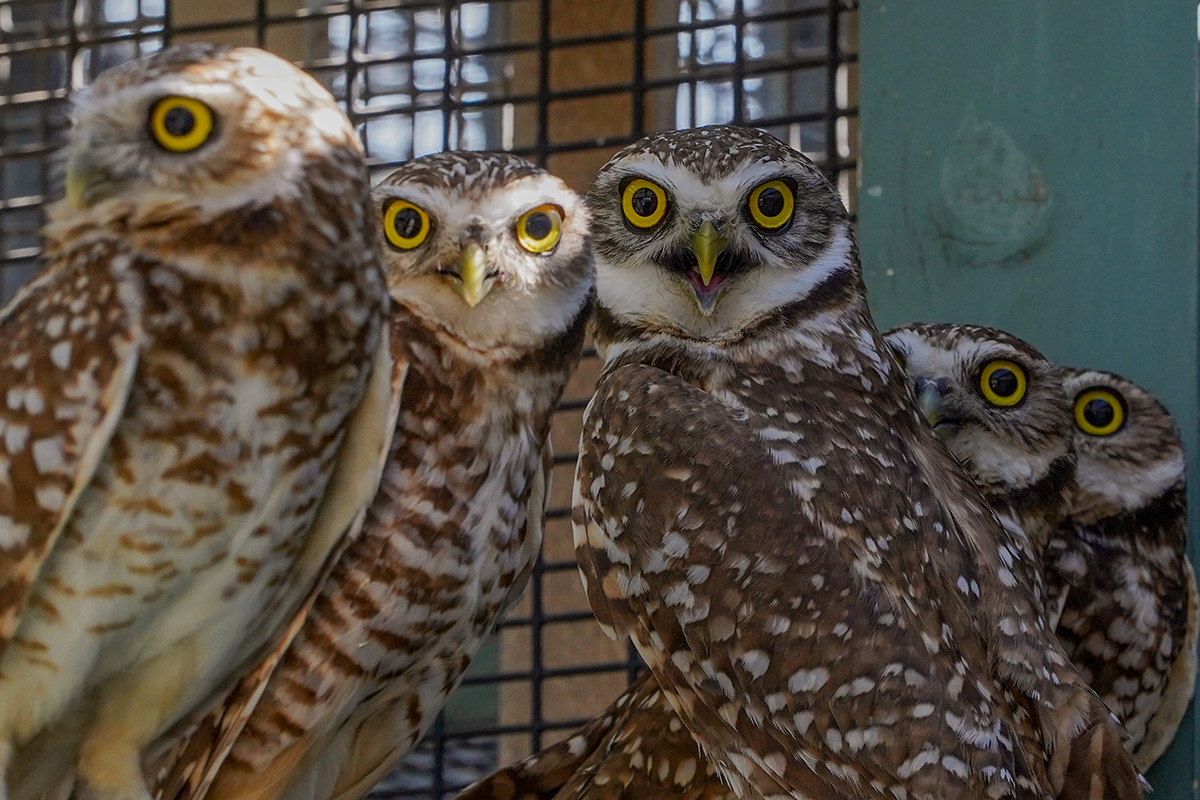
Burrowing owls perch together at the Wild at Heart aviary in Cave Creek on March 15. The owls have since been relocated to artificial burrows near Florence. (Photo by Samantha Chow/Cronkite News)
Wild at Heart is dedicated to rescuing injured hawks, falcons, eagles and owls, rehabilitating these birds of prey and eventually releasing them back into the wild.
“What we want to do is get in there, get the owls away from trouble and put them into the relocation program so they don’t die,” Clark said.
Despite federal protections under the Migratory Bird Treaty Act, burrowing owls remain threatened by land development. Clark said developers have been working with Wild at Heart for 25 years to report burrowing owls that are at risk.
“It’s really the developers that tell us that the owls are there, and then we go and trap those owls and get them into the program,” he said.
Through the center’s burrowing owl relocation project, the owls are captured and transported back to Wild at Heart’s care facility in Cave Creek, where they’re held until a new location in the wild has been designated for the owls and artificial burrows have been installed.
The burrowing owl is a ground-dwelling species that nests in burrows in open, treeless spaces. They can’t dig their own burrows, so the owls live and raise their young in burrows abandoned by badgers, coyotes, skunks, kangaroo rats and ground squirrels.
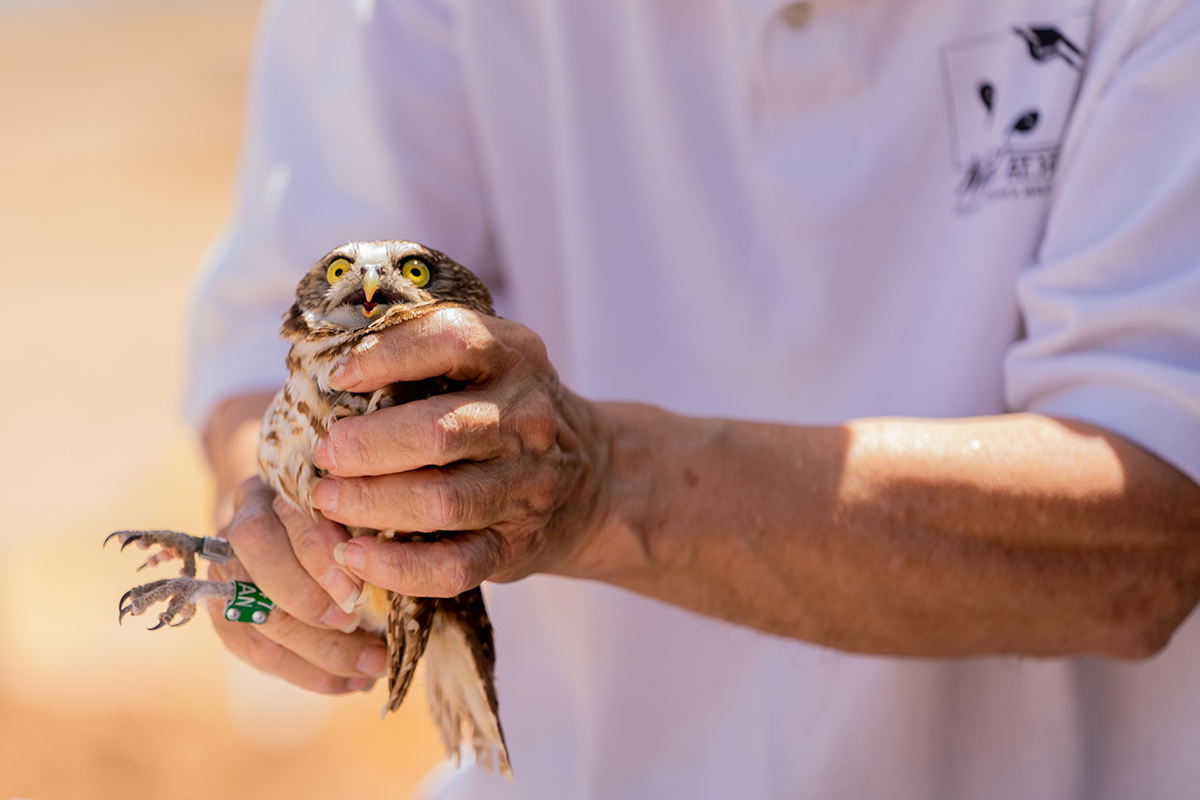
Greg Clark, burrowing owl habitat coordinator for Wild at Heart, holds a burrowing owl for volunteers to see before releasing it into its tent near Florence on April 9. The owls are placed in pairs into artificial burrows.
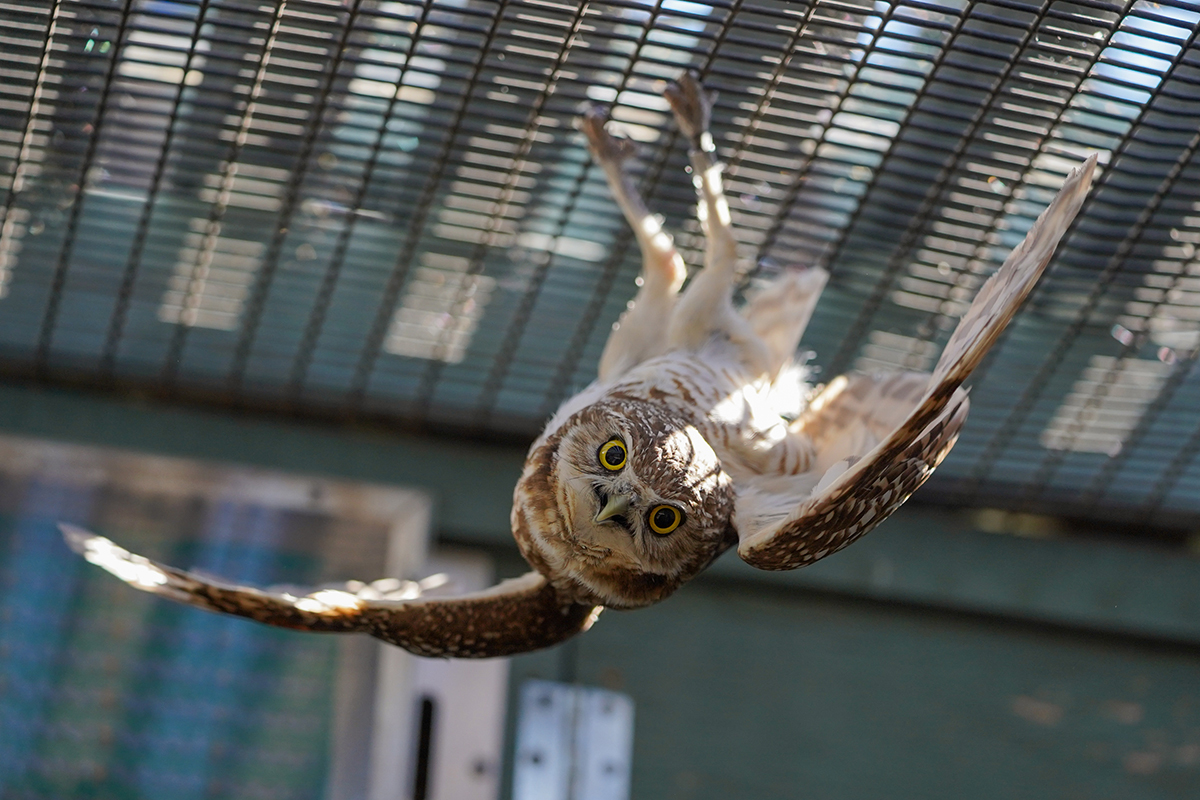
A burrowing owl hangs upside down at the Wild at Heart aviary in Cave Creek on March 15. (Photos by Samantha Chow/Cronkite News)
Left: Greg Clark, burrowing owl habitat coordinator for Wild at Heart, holds a burrowing owl for volunteers to see before releasing it into its tent near Florence on April 9. The owls are placed in pairs into artificial burrows. Right: A burrowing owl hangs upside down at the Wild at Heart aviary in Cave Creek on March 15. (Photos by Samantha Chow/Cronkite News)
Clark said the artificial burrows consist of an in-ground upside-down 55-gallon bucket that has been cut in half with tubes that loop up to the ground surface. Meshed wire, cable ties, steel wire, cinder blocks and rebar also are used to make the burrows, which are designed to mimic the owls’ natural tunnels and nests.
With assistance from Audubon Arizona, a nonprofit organization dedicated to protecting birds and their habitats, Wild at Heart employees and volunteers erect large, enclosed tents over the artificial burrows. The owls are kept in the tents for 30 days to prevent them from returning to their previous nests.
“When the owls are in the release tents, they are fed frozen mice every day,” said Cathy Wise, the community science manager of Audubon Arizona. “So we need volunteers that do that, too. They go out each day and record carefully what the birds are eating.”
Bob Fox, co-founder of Wild at Heart, said the owls continue to get help after the tents are removed.
“We supplement feed for another week to 10 days to allow the males time to develop good hunting territory and hunting strategy,” he said.
Since 2012, Fox said, Wild at Heart has relocated 1,164 burrowing owls and built artificial burrows “all over the state.”
Relocated owls need to be placed in an area that contains few trees and has adequate food and water sources, Fox said. Wise has found that the owls thrive when their new burrows are adjacent to an agricultural area.
“It’s important that we place the owls adjacent to agricultural areas that are being irrigated,” Wise said. “We typically can see a difference almost right away. As our work progresses, we’re seeing grasshoppers, snakes and a lot more wildlife, which is good. It means that the area is being supported.”
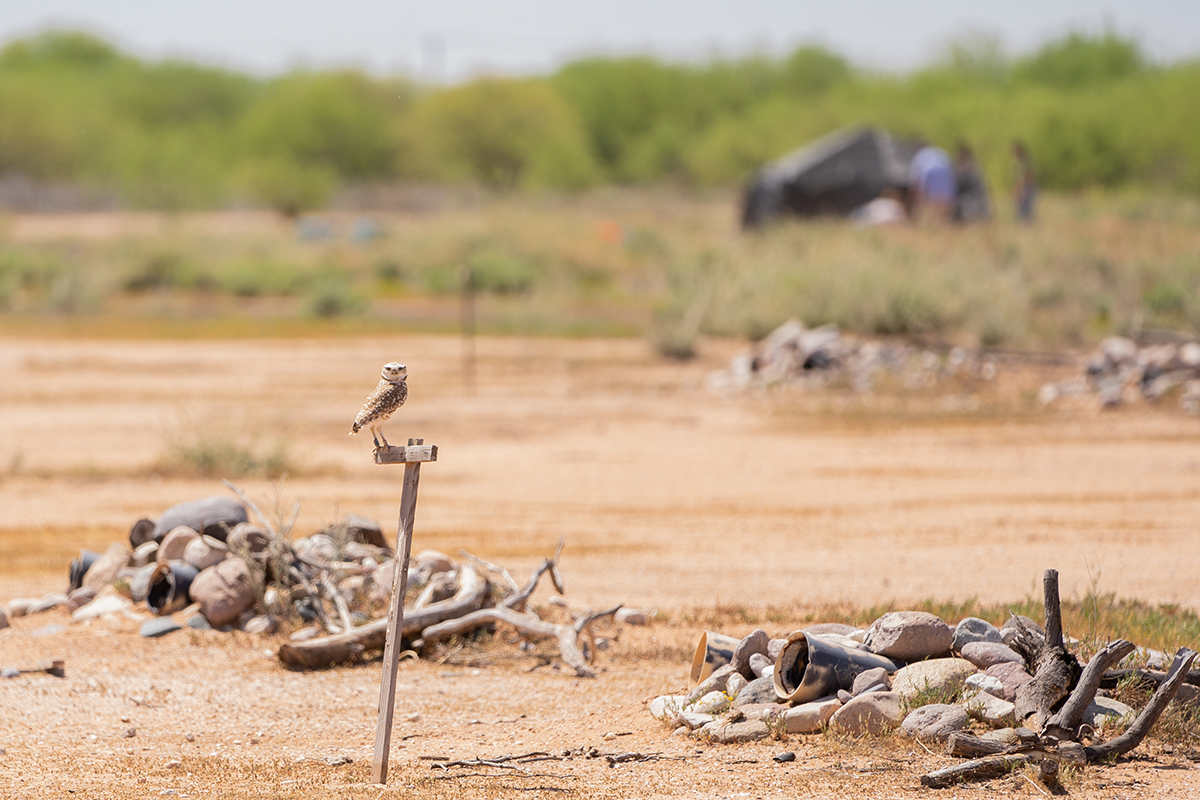
A burrowing owl watches over its artificial burrow near Florence. The owls remain in tents for 30 days; after that, volunteers will continue to feed them for a week or so to allow the males time to develop good hunting territories and strategies. (Photo by Samantha Chow/Cronkite News)

Wild at Heart volunteer Tim Campbell shovels dirt to help hold down a tent for the burrowing owls. Campbell heard about the volunteer opportunity to help the birds through a work event at Freeport-McMoRan.
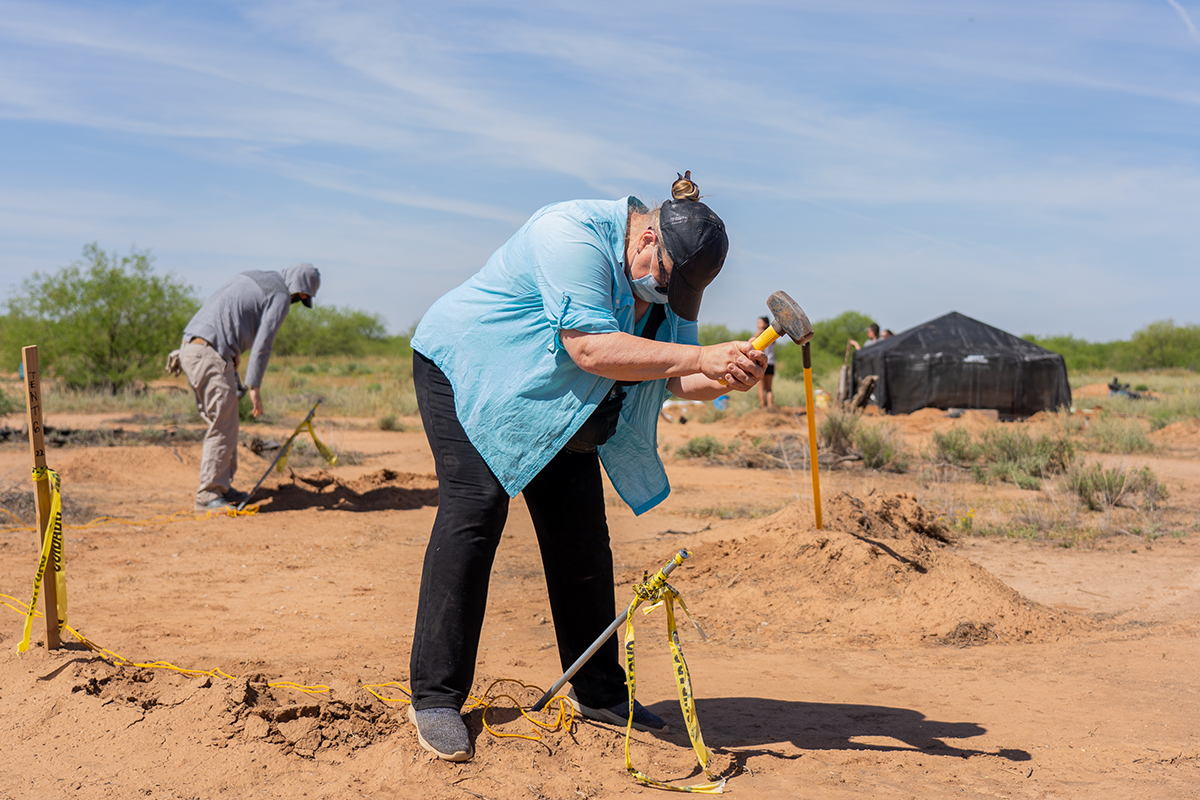
Wild at Heart volunteer Tammy Digiacomo hammers stakes into the ground to build a tent for some of the 20 burrowing owls relocated near Florence in April. The owls will be confined to the tents, which contain artificial burrows, for 30 days to prevent them from seeking out their previous home near Buckeye. (Photos by Samantha Chow/Cronkite News)
Left: Wild at Heart volunteer Tim Campbell shovels dirt to help hold down a tent for the burrowing owls. Campbell heard about the volunteer opportunity to help the birds through a work event at Freeport-McMoRan. Right: Wild at Heart volunteer Tammy Digiacomo hammers stakes into the ground to build a tent for some of the 20 burrowing owls relocated near Florence in April. The owls will be confined to the tents, which contain artificial burrows, for 30 days to prevent them from seeking out their previous home near Buckeye. (Photos by Samantha Chow/Cronkite News)
Although burrowing owls are listed as endangered or threatened in several states, Fox and Wise believe the owls should remain a species of concern in Arizona because listing a species as endangered can create issues.
“The burrowing owls are a little different because they live underground and they are not always visible,” Fox said. “So, oftentimes, people just come in and bulldoze and say ‘Oh, I didn’t know.’ If you have an endangered species on a site, you’re prohibited from doing any construction and building around that area.”
In addition to development, Wise said the owls are suffering from climate change and drought conditions.
“It’s kind of a cascading effect,” she said. “With the prolonged drought, we’re seeing less vegetation that supports the insects and rodents that the owls need.”
Audubon’s climate models predict that burrowing owls could lose 77% of their current breeding range by 2080. The models also predict that climate change will disrupt the owls’ winter range, leaving only 33% intact. Western burrowing owls range from the Mississippi River to the Pacific Ocean, north into Canada and south into Mexico.
Burrowing owls also face threats from pesticides, shootings, entanglements in fences and other manmade hazards. Modern agricultural practices also have displaced the prairie dogs and ground squirrels that burrowing owls depend on for nesting burrows.
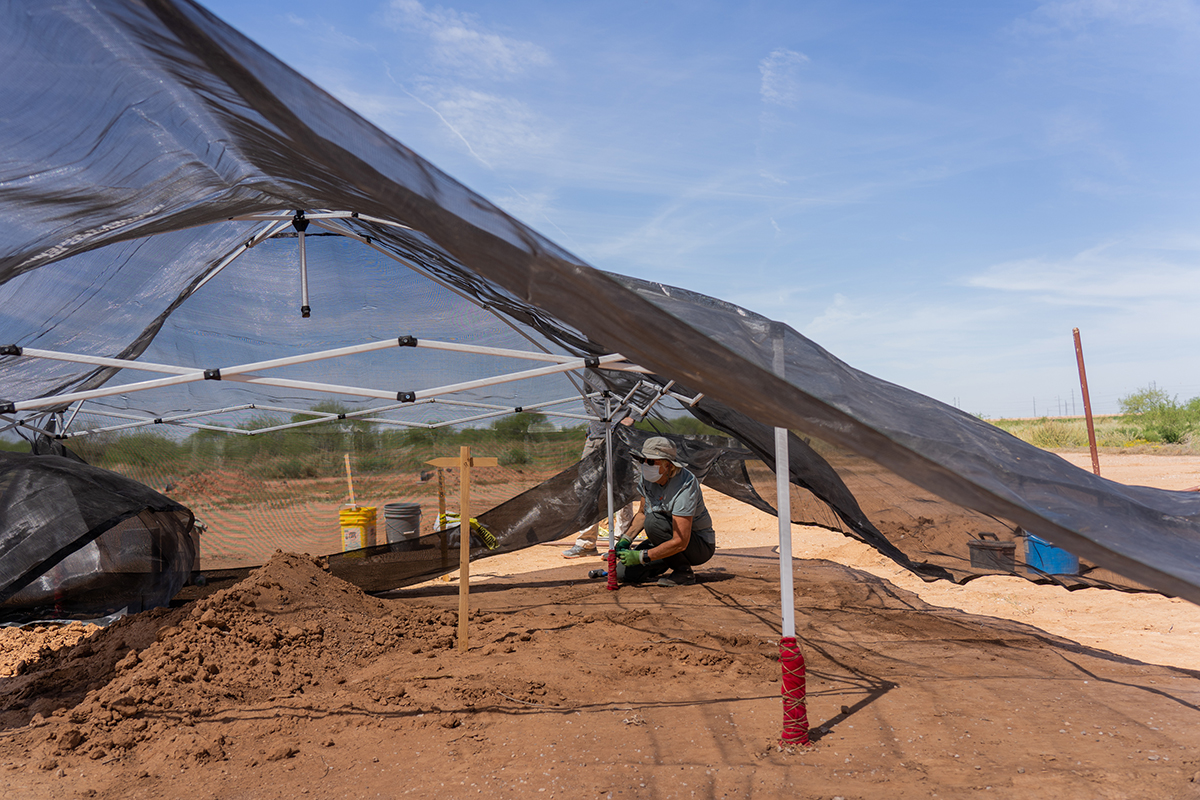
Volunteer Marj Pals crouches down as netting is laid over the frame of a tent that will isolate relocated burrowing owls near Florence.
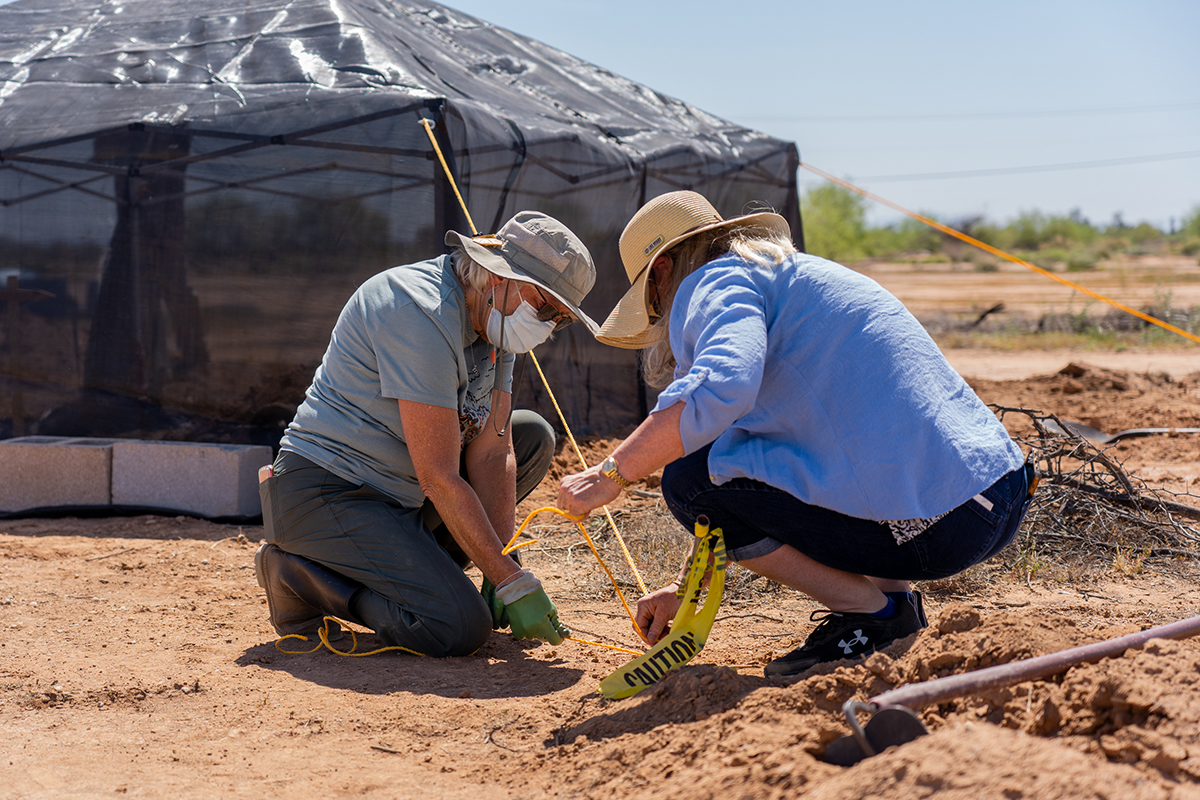
Jeanette Merritt, right, and Marj Pals tether a tent to stakes as part of Wild at Heart’s efforts to relocate 20 burrowing owls from Buckeye. (Photos by Samantha Chow/Cronkite News)
Left: Volunteer Marj Pals crouches down as netting is laid over the frame of a tent that will isolate relocated burrowing owls near Florence. Right: Jeanette Merritt, right, and Marj Pals tether a tent to stakes as part of Wild at Heart’s efforts to relocate 20 burrowing owls from Buckeye. (Photos by Samantha Chow/Cronkite News)
Fox said he has found displaced burrowing owls near streets, sidewalks and parking lot drains.
“They’re really starving for habitat,” he said. “So if we can create viable artificial burrow systems for them and a good habitat, it increases the likelihood that they will survive and thrive.”
As construction continues across much of the state, Wise said, there is an increased need to relocate burrowing owls in areas outside the Phoenix area.
“It seems like we’re sort of running out of places now,” she said. “There are still birds that need to be relocated, and as there’s projects going further and further west, we’re seeing it’s kind of like a boom or bust.”
As metro Phoenix continues to grow, Wise said the owls have to be relocated again.
“The construction just keeps going on and on,” she said. “So we’re losing those open spaces, and even if the open spaces are preserved, the areas around it are being developed. So instead of farm fields, you’ve got housing developments.”
Wise stressed the importance of public awareness for the issues that burrowing owls face and the need for volunteers to help relocate the owls.
“We need to be very mindful and cognizant of what we’re doing long term and how we’re caring for the owls to make sure that their numbers don’t get any lower,” Wise said.
(Video by Raven Payne/Cronkite News)